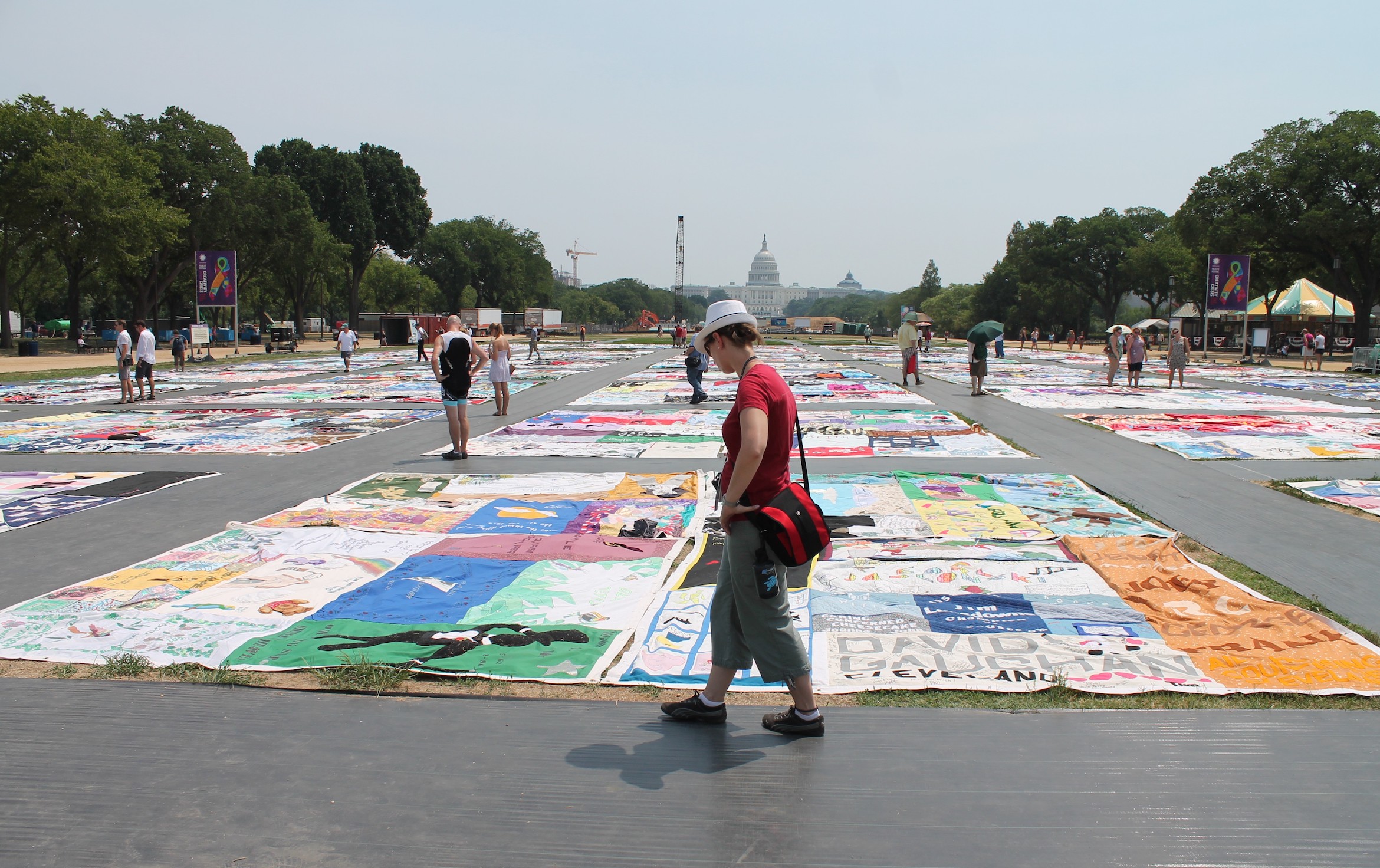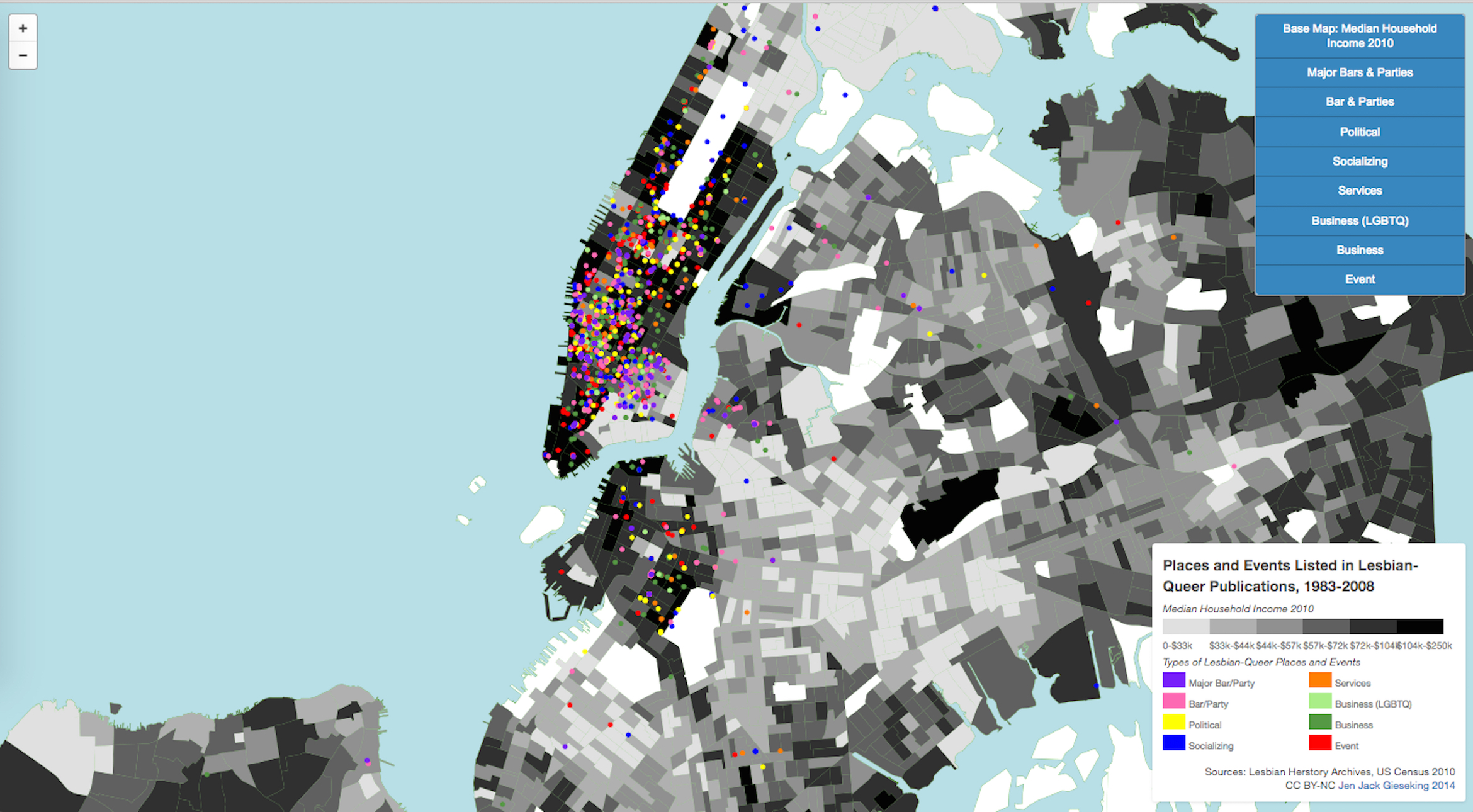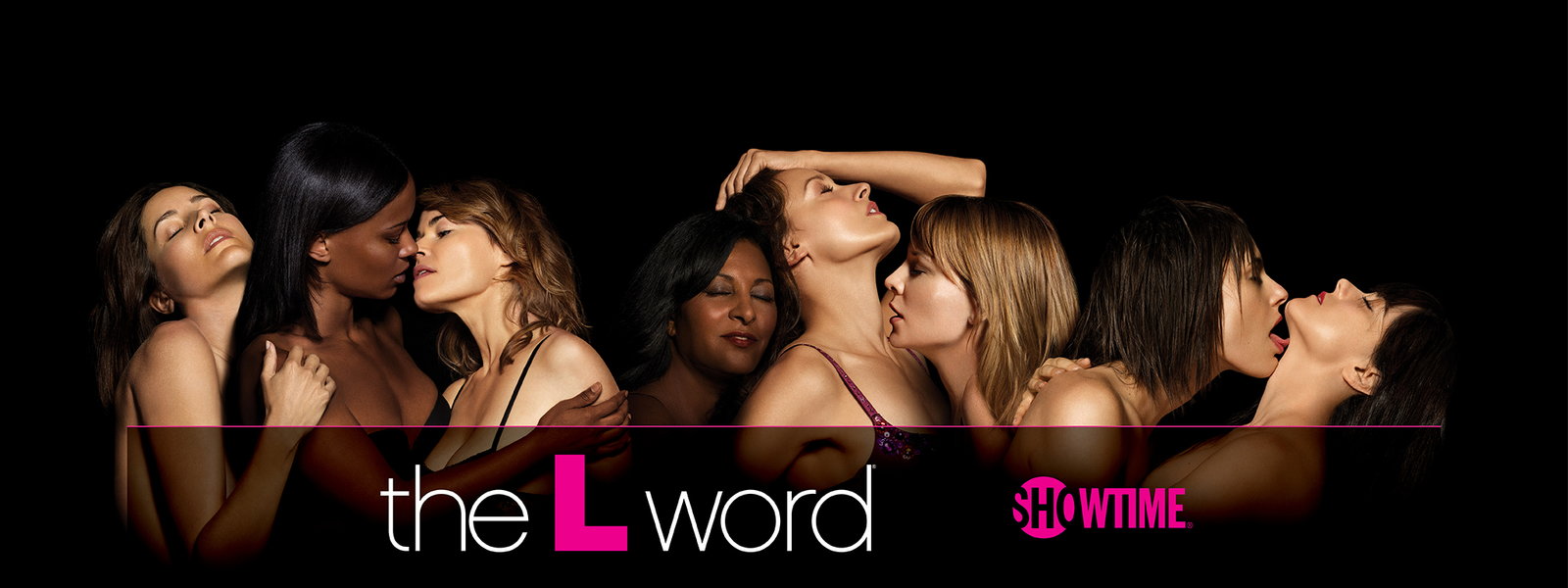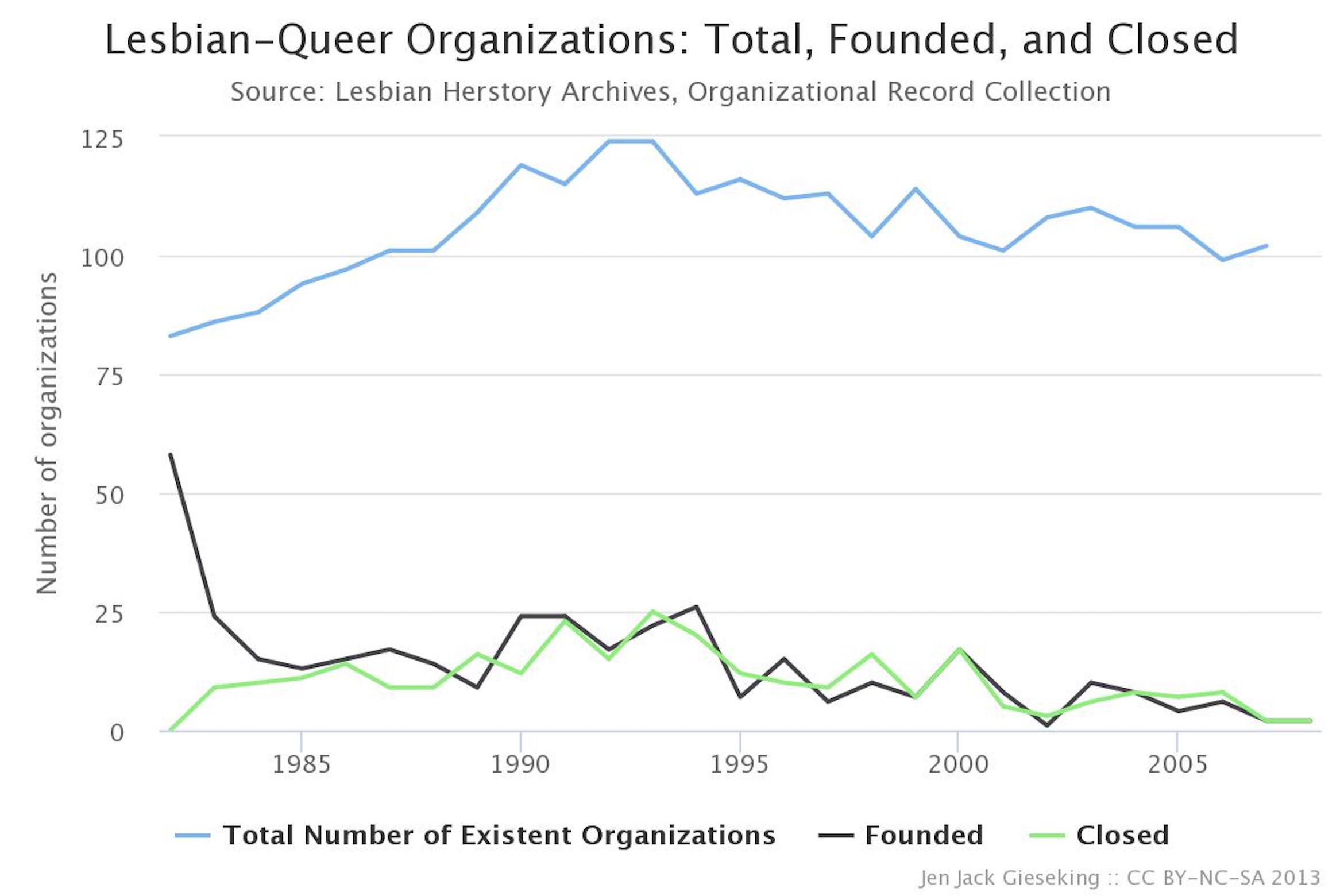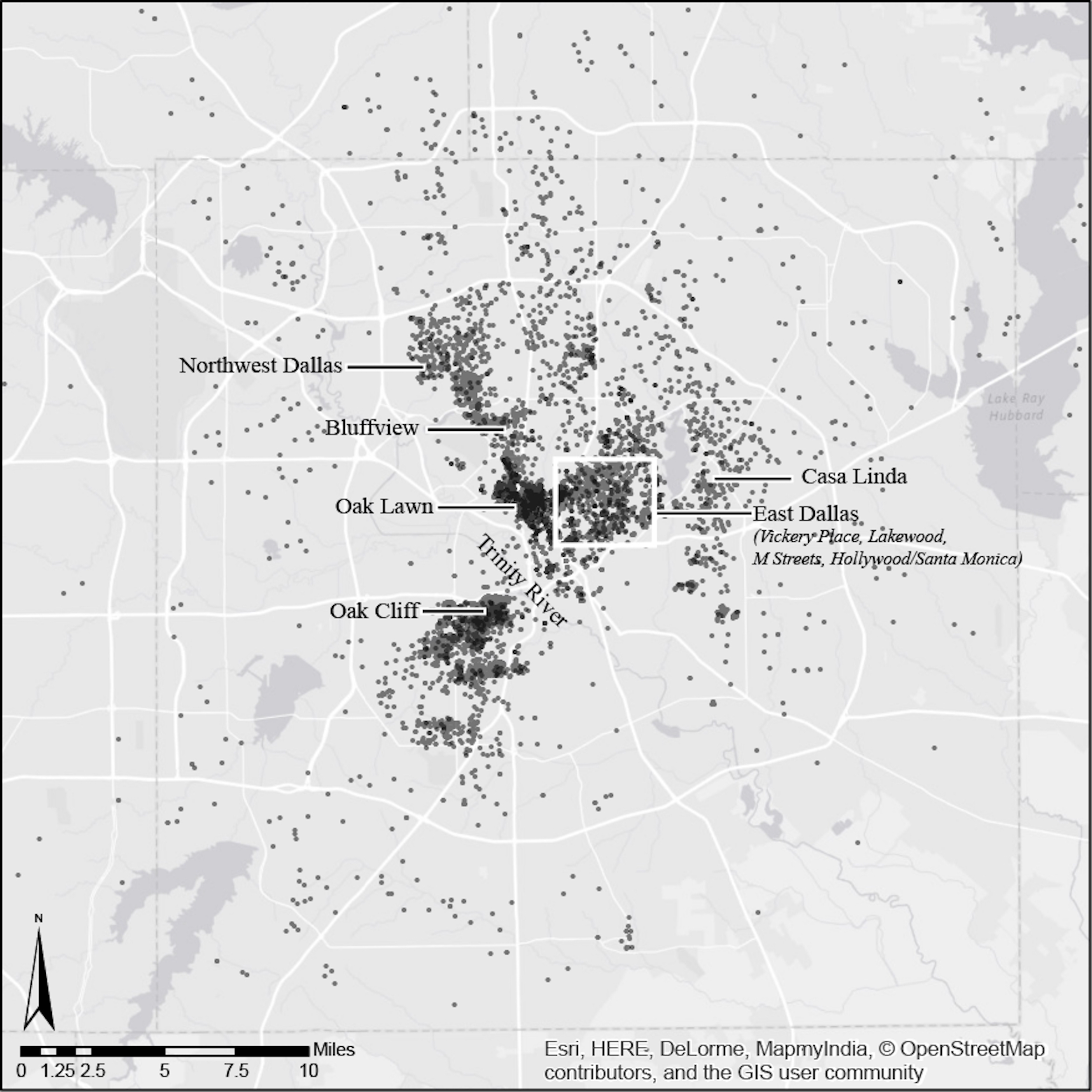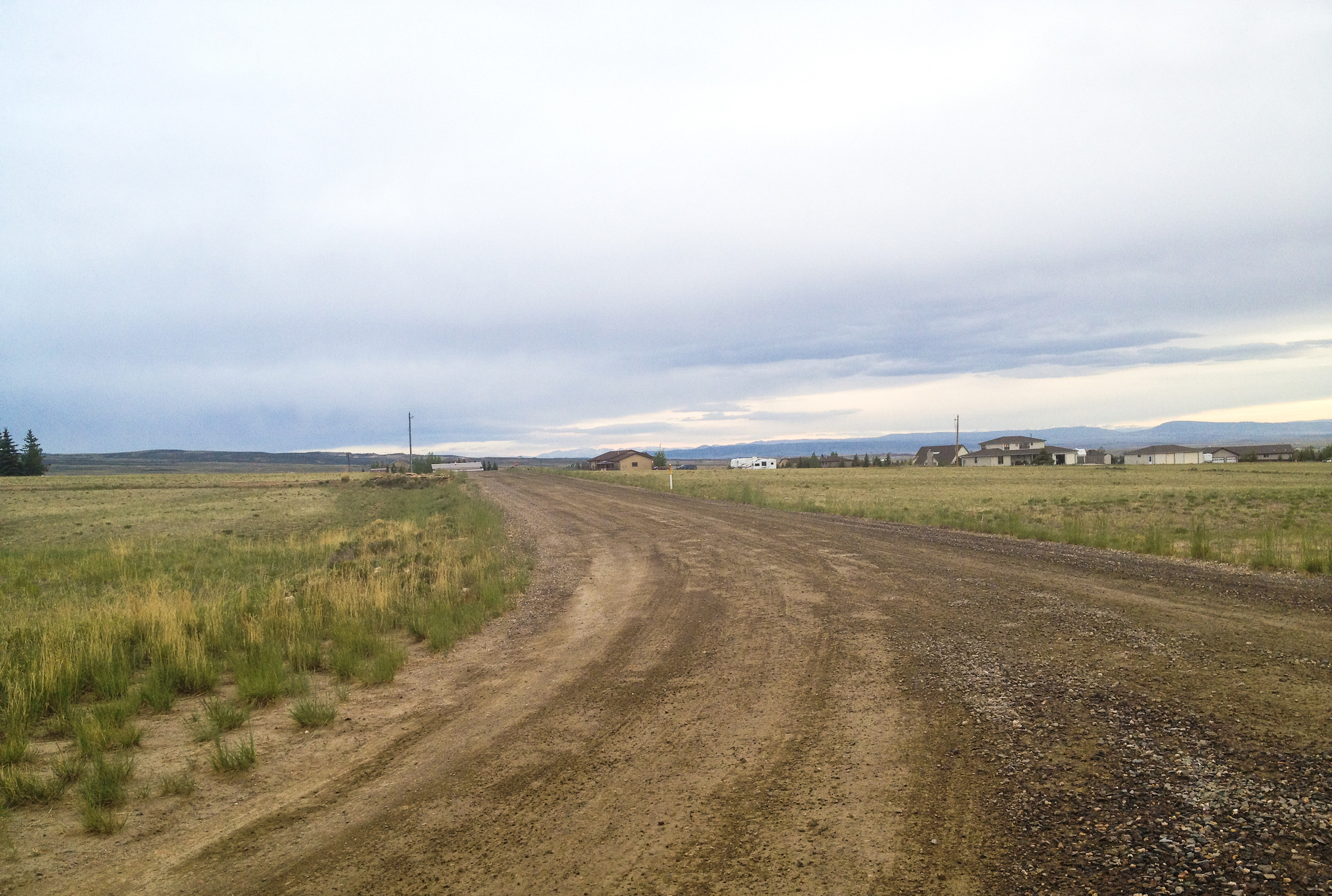Intersections
As designers and urbanists engage with LGBTQ+ identity, what role do gender and sexuality play in the preservation, design, and management of urban space today?
In This SeriesWe are celebrating 15 years — and counting — of stories that are deeply researched and deeply felt, that build a historical record of what the city has been.
Defining and representing what might be understood as “queer space” is no easy task: myriad sites may be associated with individual and collective histories, but the creation of a shared story sets limits on what’s included. Nowhere is that challenge more richly laid bare than in New York City, and no one knows it better than Jen Jack Gieseking, author of the forthcoming book A Queer New York: Geographies of Lesbians, Dykes, and Queer Women, 1983-2008. In this interview, Gieseking draws our attention to the ever shifting, often contradictory constellations of LGBTQ+ spaces — urban and rural, destructive and triumphant — asking not only what they share, but also how they might be shared with those interested in the queer spaces that are yet to come. – JM
Though I know it’s still very much in progress, could you tell me about your book project A Queer New York?
Certainly. My work is inspired by a few questions: How do LGBTQ+ (lesbian, gay, bisexual, transgender, queer, and other gender and sexual minorities) people — namely lesbians and queers among them — produce space? And, in pursuing that question, how do we record the historical geographies of a group most often referred to as “invisible”? Unfortunately many LGBTQ spaces are left out of the American historical record, especially spaces of understudied groups such as women and gender non-conforming people (GNCP). New York City, an LGBTQ hub, has only three scholarly volumes on its LGBTQ history and no lesbian-specific history among them. Similarly, only a handful of lesbian-specific, full-book histories of American lives exist.
LGBTQ neighborhoods like Greenwich Village are a hallmark in the popular imagination, but these spaces have always been the domain of men, due to the gender pay gap. In response to this absence, my book argues that, unlike the territorial neighborhoods gay men or mixed-gender ethnic groups frequent, such as a Little Italy or Chinatown, lesbian and queer spaces are fragmented and fleeting; they come and go like stars in the sky. It is these women’s and GNCP’s bodies that bind these spaces together and make for a lesbian-queer production of space I call constellations.
My interest is in making sense of how lesbians and queers (by which I refer to queer women, ftms, mtfs, and other GNCP in this case) produce space in contrast to a more masculine territorial model. When I say “produce space,” I mean making, creating, and sustaining physical, digital, and social spaces and places. Bars are the first obvious case, and the most referenced gay space, where the difference can be seen. For example, while gay men had nearly 60 bars in Manhattan under 57th Street in 2008, lesbians had three in the same area! Park Slope, once deemed a lesbian neighborhood, is no longer a place for young dykes, lesbians, and queers to move to — because they cannot afford it or no longer feel that Park Slope is a queer stronghold.
Cities are portrayed as inhospitable to women, especially to women’s bodies in public, and GNCP are unwelcome and unsafe in most places, urban or otherwise. At the same time, every time I give a talk and ask my audience where they would look for a gay person if tasked with finding one, they reply, straight and queer alike: cities, gay neighborhoods, and gay bars. This city-neighborhood-bar triumvirate that defines the public’s geographical imagination of queer life needs to be upended — or queered, really — on the basis of gender, race, class, and disability. I hope my work contributes to that sort of broader thinking by showing the complicated, varied, and often more partial and peripheral sorts of spaces that queers depend upon to survive and thrive.
And alongside the book you’re working on a digital project?
This is a really important component that’ll allow me to bring the lives of lesbian and queer Americans more directly to the public. It’s an interactive website called “A Queer New York: Mapping Lesbian and Queer NYC History” (AQNY). The site will enhance public conception of LGBTQ history through mapping a vast amount of archival material, original content, and images. Recording not only well-known bars, community centers, and activist interventions, the AQNY site will also map everyday lesbian and queer spaces. The site is also timely, as the National Park Service (NPS) announced in 2016 that it would identify and list LGBTQ historic places as a key element of official US history.
In the essay you wrote for the NPS report, LGBTQ America, you talk about the way the broader cultural acceptance toward LGBTQ people has affected the way that “official” LGBTQ spaces are themselves diversifying.
Having interviewed lesbians and queer women who came out in New York City between 1983 and 2008 for A Queer New York, it feels like we have such limited access to our history as LGBTQ people. We don’t really talk about what happened in the 1970s and before, with the exception of the Stonewall Riot and, sometimes, other uprisings like the Compton’s Cafeteria Riot. There is a very limited notion of LGBTQ history that LGBTQ people pass around: the emergence of gay “neighborhoods” in the 1980s, suddenly there’s AIDS, and then there’s all of this activism, which led to all of this community in the 1980s and 1990s. And then queer theory gains a certain prominence, which filters into the education system, while the commodification and sexualization of gay and lesbian lives takes center stage in popular culture, until eventually we have shows like Queer as Folk and The L Word. And then, suddenly, there’s very few narratives of gay men, some new narratives of trans lives, and no lesbian stories left except those focused on marriage and living happily ever after since Obergefell v. Hodges. It’s all been told, supposedly. But it has not! That’s a very white, very middle class narrative.
One way, we — by which I mean LGBTQ people and straight and/or cisgender people alike — can push back is to refuse this “post-gay” identity that gay, conservative political commentator Andrew Sullivan asserts, that lesbians and gays no longer need or desire neighborhoods of their own, and choose to “assimilate” into less sexually segregated neighborhoods. Sullivan’s approach also disavows trans people as part of the sexual minority struggle, and what he advocates is both for and from a very white, privileged, middle-upper class male experience. This trend is said to be linked to people coming out at younger and younger ages, and a lot of people rejecting what they feel are unnecessarily centralized identities like “straight” or “gay.” But while younger people may be against labeling, it is only wealthy, cisgendered, able-bodied, white men who can claim that their sexuality and gender do not influence their lives. I doubt many working class, poor people, people of color, gender minorities, people with disabilities feel like things couldn’t improve, especially in terms of the spaces they inhabit.
Of course, the other thing that is shaping our everyday geographies, within and outside of big cities, is the internet. People are finding each other in these niches: “I didn’t know that you were also ftm, made pottery, and liked My Little Pony,” etc. So there can start to be a group of us — whomever that “us” is. There was a great promise for the internet to be a very democratic space, especially before social media was so totalizing. Americans thought there was this amazing sense of connectivity and openness to be found online, poignantly at the same moment that the price of physical spaces was exploding exponentially. Among queers, there’s always a way to survive and thrive, so I think a lot of that acceptance entails, “Oh, I see people like me, even if they’re online.” But is that really enough?
We also need to think about why we had so many diverse spaces in recent decades. In my interviews and archival research, it stood out to me that there was really intense community-building through AIDS activism in the 1980s and 1990s. Soon afterward, especially in New York, you can just see a steady climb in the number of LGBTQ organizations year after year. The number of groups peaks in the early 1990s, and then begins to flatten. When Clinton defunded the welfare state in the mid-‘90s, a culture of philanthropy replaced it. Because of all this organizing and activism, LGBTQ people and issues were able to really become a part of that philanthropic infrastructure. Making a space that’s truly queer takes a lot of time and effort, and the same time and effort — and capital, often — is required to sustain it.
One of the founders of the NYC LGBT Historic Sites Project, Jay Shockley, indicated that they debated whether to include “Q” in the project’s title, but that the decision ultimately to not include it was based on the understanding that many of the included sites were made significant at a time when the term “queer” wasn’t really in use. You’ve written about how that word might be useful ahistorically, so I’m wondering what use that word might serve now as we’re thinking about making and holding spaces that don’t essentialize.
I think what’s great about “queer” is its ability to help everyone think about the fact that spaces were never so simple, or never so completely related to only one identity, or any coherent identity. We did use “Q” in the LGBTQ Heritage Theme Study, and the reason is that the advisory committee of scholars, architects, historians, and preservationists that the National Parks Service brought in (which was a life highlight, I tell you) requested they include the Q.
Most of the places and spaces in LGBTQ history have been fragmented, peripheral, or partial. Neighborhoods exist in our geographical imaginations, but LGBTQ places are all over the place. They’re all over cities and rural environments and towns, and they move around. They’re traveling parties, or they’re just fleeting, they don’t last forever. It’s powerful to think that spaces are being created now that will be monuments in the future. Other spaces will be, are, and have been traveling spaces. In my essay I cite the Names Project AIDS quilt. I got a lot of pushback from some colleagues, saying it wasn’t a space per se. Most people associate it with the National Mall in Washington, D.C. since it was most famously displayed there multiple times. But it’s definitely in a queer space.
I was really taken by your underlining of the fact that we’ve been trained to think of LGBTQ spaces as predominantly urban. If we think about them as networks — which your idea of “constellations” relates to — they importantly include many sites that are decidedly non-urban, as well as sites that are more amorphous or in motion. How might someone invested in “making the invisible visible,” so to speak, think about how to begin to represent some of these sites or moments that resist being fixed?
Now you’re singing the lifelong song of angst and possibility of the queer geographer! Larry Knopp and Michael Brown worked with this huge group of LGBTQ people from different generations, classes, races, and nationalities — people with very different histories, very different experiences of the city — to make a public map of LGBTQ history in Seattle. And it generated a huge debate! What counts as “gay”? What counts as “lesbian”? And at what point in time? How many LGBTQ bodies had to be in a place and for how long? How significant is significant enough to be mapped? Even when you get LGBTQ people in a room, they’re never going to agree about what LGBTQ history is, because they were never taught LGBTQ history to start with. As a social scientist trying to make a two-dimensional, authoritarian map, it’s really kind of shattering; and it should be. It really upsets one’s notion of what maps and history are and can be. I think the key is to bring in different sorts of sources.
There’s also this great work from Michael Smart and Andrew Whittemore[1], where they went through maybe 30, 40 years of local Dallas gay publications and mapped every apartment or house listing. As a result, you could actually track gay male gentrification through Dallas over generations. At the same time, you also see the development of gay male neighborhoods in Dallas and can make sense of why they have lasted so long, and the politics and economy required to make that possible.
On the website I’m building, I use publications that list events, advertisements, or meeting spaces to map lesbian-queer parties, political organizing, and businesses. But these maps leave out the other places LGBTQ people recall as queer. For example, let’s say you and your friends met at the pizza place after you went to the dyke bar every Friday — it was queer at that moment. When you make these maps open to the public for input and adaptation, there’s an ability to record those sort of missing spaces, but, at the same time, people who want to add to the map may feel a kind of a nervousness that spaces don’t count as “gay enough.” So here we can see how difficult it is to make the visible invisible, when LGBTQ people have survived and thrived negotiating the very line between visibility and invisibility. Recording that line on a map implies an “official” history that many people do not feel a part of in their everyday lives.
In the NYC LGBT Historic Sites project, they go to great lengths to make sure the roster includes spaces made significant by LGBTQ people but also spaces that have significance for LGBTQ people. And I was taken by your insistence that something like neighborhood gentrification, like in Dallas, is not always positive, and yet it’s extremely important to mark nonetheless.
Exactly. Looking back, I think there are two sorts of spaces that tend to get reported. There are those spaces where we fought and we won some kind of right, such as Stonewall. And then there’s the Matthew Shepard beating site in Laramie, Wyoming, which marks a space of loss and sadness. I know so many people that went there on a sort of pilgrimage. Or the UpStairs Lounge in New Orleans, where mostly gay men of color were locked inside and the place was on fire in 1973, and 32 gay men died. This was the deadliest simultaneous attack against LGBTQ people until Orlando in 2016. So that’s the two categories: the spaces of victory and the spaces of tragedy. I remember one reporter asking me after the LGBTQ Heritage Theme Study launched, “How are you going to stop the monuments from just being a list of spaces of tragedy and loss?” Of course, we really need to mark those spaces, but we also need to mark other sorts of spaces that evoke other experiences. To that end, preservationists and archivists and researchers have the responsibility to think beyond these categories, and to be sure not only to record the lives of white people, men, the able-bodied, and the young. I think when it comes to public stories, there is so much gay loneliness, lesbian solitude, whatever you might call it, and that pain really speaks to LGBTQ people as much as the stories of celebration or commemoration. Sometimes important spaces — like those we affect by gentrification, for example — don’t fit neatly into any of those categories.
I was taken by an essay you wrote while doing archival research in the Lesbian Herstory Archives in Brooklyn — the largest lesbian archive in the world — where you spoke about the idea of “in/stability.” I’m wondering about how different ways of making history stack up against one another. How does something like oral history relate to pinning sites on a map? What tensions or redundancies exist between the two?
It’s funny you would ask that. The number of people who could have told me the wrong locations of so many places when I interviewed them. So many of my research participants would talk about a great traveling party the ’90s, and people would say, “Oh it was here, this place — wait, no, it was this place.” And another person would refute, “No, you got it wrong,” and back and forth. That happened often when discussing the lesbian-queer party the Clit Club. In fact, the Clit Club moved locations over the years but, depending upon when you went — which for most people is not every week — you could not know that.
People tend to get really upset and defensive when they’re just on their own sharing these stories, because it’s their history and it’s their life and they’re each right. But while they may be really, really right, they’re not always correct.
In my research, I asked my participants to draw mental maps of the spaces and places important to them to focus our conversations on their geographies. So what do they create? These powerful, sad, beautiful, deep, and even hilarious drawings of New York. Park Slope is labeled “Dyke Slope” on more than one map, and there’s one map where one participant put a plus one everywhere she made out with somebody. I didn’t ask her to do it, but it was just awesome. The map that sticks with me the most is from a research participant I refer to as Naomi, an African-American woman who came out in 1989. She drew this line right down the middle of Manhattan on her mental map. I knew that was not Broadway which runs at a sort of a diagonal so I asked why she had a line there. She shared with me and her co-interviewees that she got attacked there once, so she still doesn’t hold hands crossing Sixth Avenue. It floored me to take in a lived geography that I might not have seen by just chatting with her.
Is there any kind of systematic way that you think about your own personal identity and its connection to your work?
When I do the interviews, I’m very much in that moment with my subjects. I’d tell stories saying, “Oh yeah, my ex-girlfriend too,” or “I went to that bar; I remember that bartender.” And then it became striking to me when I had all of our stories together I started to hear things like, “I’m fortunate I was never hit.” Or, “I’m lucky no one’s ever come after me on the street.” And I started to see the fears of all of my participants, the gender discrimination facing butch and GNCP participants, and the white privilege, class privilege, and racism apparent in these stories and spaces that afforded “safety” to some and marked others, namely brown and black bodies, as “at risk” and “dangerous.” And, for all of my participants, a deep sadness they experienced as a state of dispossession from their own claim to the city. At first it was really sad transcribing the interviews, and also painful to me as I recognized my own stories alongside the women and GNCP in my research.
Also, over time, this research helped me make sense of my own autobiography. C. Wright Mills was a sociologist who wrote about the sociological imagination: seeing your own biography in the moment in history in which you’re living it, or, in other words, how social systems and structures have shaped your lives and how your actions, words, and identities shape them. I think for queer people, we really don’t get a chance to do that much. I write a lot about the geographical imagination, or the ways we envision spaces to be and the gap between how we experience them to be, and how that gap shapes our sense of self and the world. I think US LGBTQ monuments and historic sites can do that not just for LGBTQ people but for straight people, for cis people: that all people can experience LGBTQ life and existence as part of their history, to question their own notions of gender and sexuality, space and history, and in doing so queer their ways of thinking and the culture around them, now and in the future.
From Michael J. Smart and Andrew H. Whittemore,“There Goes the Gaybourhood? Dispersion and Clustering in a Gay and Lesbian Real Estate Market in Dallas TX, 1986–2012.” Urban Studies 54: 3 (2017): 605.
The views expressed here are those of the authors only and do not reflect the position of The Architectural League of New York.
As designers and urbanists engage with LGBTQ+ identity, what role do gender and sexuality play in the preservation, design, and management of urban space today?
In This Series
